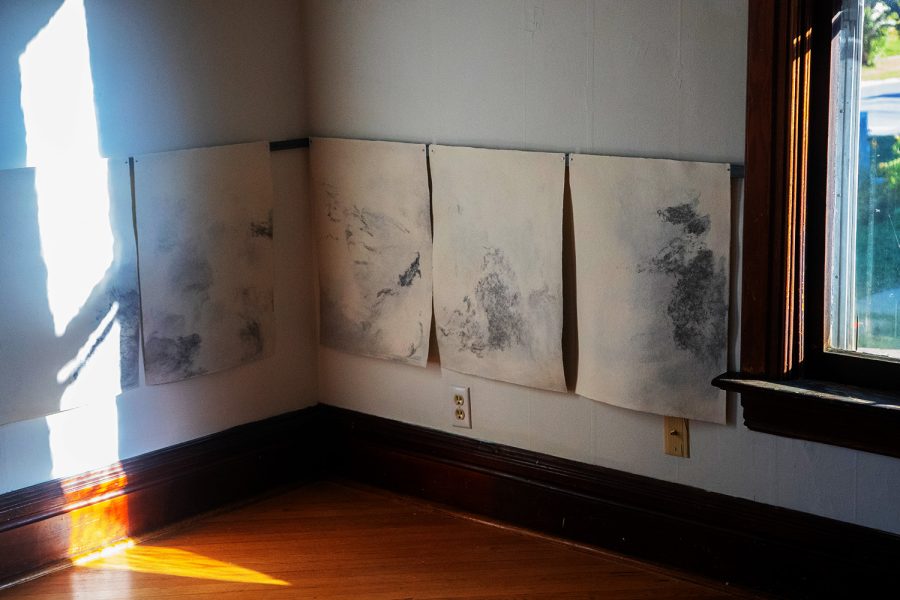Public Space One offers paper-making experiences for ‘No Coming, No Going’ September exhibit
Interdisciplinary artist Nicholas Cladis offers the public the chance to experience the art of papermaking at PS1’s North Gallery for his “No Coming, No Going” September exhibition.
The paper-based art pieces hang all around the walls of the exhibit room, illuminated by natural light, at Public Space One on Thursday, Sept. 29, 2022.
September 29, 2022
The ‘No Coming, No Going’ exhibit hangs elegantly in Public Space One’s North Gallery on N. Gilbert Street. Handmade paper stained with dye spans the room in a horizontal line in the order in which it was made. Stacked off to the side are handmade paper pillows to be used as cushions for anyone who wants to sit in reflective silence amid the artwork.
Exhibit organizer Nicholas Cladis is an artist who specializes in the art of papermaking. He has been studying abroad to learn paper making for twelve years, six of which he spent in Japan. He spent his residence in the Japanese traditional papermaking village of Echizen outside of Kyoto from 2014-2020.
At the time, many people in Japan were moving from the countryside to cities, leaving behind large, empty houses. While in Echizen, Cladis participated in a non-profit organization that brought the houses up to code and repurposed them for site-specific galleries. His experiences in Japan had a heavy impact on Cladis, and upon moving to Iowa, he found that he lost the character of his work.
“Echizen was a really prominent part of my work, the place itself, and so I think in the last two years, it’s kind of been searching for how to bring Iowa City specifically and Iowa more generally into my work as that kind of character,” Cladis said. “This show is part of that search.”
The “No Coming, No Going” exhibit allows Cladis to repurpose a space for an art gallery, much like he did in Japan. It is also his way of bringing hands-on papermaking to Iowa with a public paper-pulling process.
During a designated paper-pulling on Sep. 17, Sep. 24, or Oct. 1, anyone interested in making a piece of paper has the opportunity to do so. The sheet that they create is dried and eventually hung in the gallery as part of the exhibit. Every piece of paper is a public contribution.
Cladis has been able to share the papermaking experience with many people, including Bree Meyland, a Riverside resident pursuing a degree in art education at the University of Iowa. She heard about the exhibit from another local artist and was excited to participate.
“I wanted to see papermaking because I’m really interested in the Center for the Book but I’m also really interested in the ways you get the public connected to the arts,” Meyland said.
The Center for the Book is a University of Iowa program dedicated to the study of the book in society. It is the home of the UI’s papermaking facility, where Cladis has introduced Japanese papermaking to several student seminars.
During the exhibit’s paper-pulling event on Saturday, Sep. 24, Cladis guided Meyland through making her own sheet. The process began with filling a plastic-lined deckle box with water. Then, Cladis instructed Meyland to stir a few scoops of hemp fiber into the water with her hands.
When she was finished, Cladis handed Meyland a bowl of dye, its color produced from cotton and soot, and she poured the dye into the water however she saw fit. The final step of the process was removing the plastic sheet, which had to be done in a way that kept the design of the dye intact. The removal of the plastic sheet allows the deckle box to drain, leaving behind two layers of dye that create a two-sided piece of paper.
RELATED: Public Space One hosts ‘INDIGO!’ art exhibition reception
Cladis asks every participant to write down their name and three sensations they felt when they were engaging with the paper. He also records the mixing step of each participant’s process so that he can compose a video after the last paper-pulling event that documents the creation of all of the pieces of paper in the exhibit. He will showcase this video during the exhibition’s closing reception.
Every piece of paper made is a unique expression of the person who made it, like a “fingerprint,” according to Cladis. It depends on the specific way each person stirs their fiber, pours their dye, and pulls their sheet.
“I think this exhibit is special because it relies on the hands of many, so people can see evidence of their own presence and the impact they have,” said Hannah Givler, the PS1 resource manager for Cladis’s gallery and Cladis’s partner. “I also think it’s special because, to me, this show is about creating and letting go.”
The act of “letting go” is the burning of all the paper during the closing reception of the exhibit on Oct. 8. Cladis described burning the paper as “returning it to the earth from whence it came.” “No Coming, No Going” is a reference to the Buddhist principle that nothing is ever created, and nothing is ever destroyed; nothing ever comes and goes.
“In the context of paper making, I just think of how paper making is just coalesced matter that comes from other places, and eventually it will return to the earth,” Cladis said.
The burning of the paper will not destroy it, but rather just change its form to smoke. Cladis applies this principle to his search for character as well.
“Maybe it’s just the idea that instead of the work existing in a place, it’s something that’s within me,” Cladis said. “It’s always going to exist no matter who’s participating or what’s part of it.”



